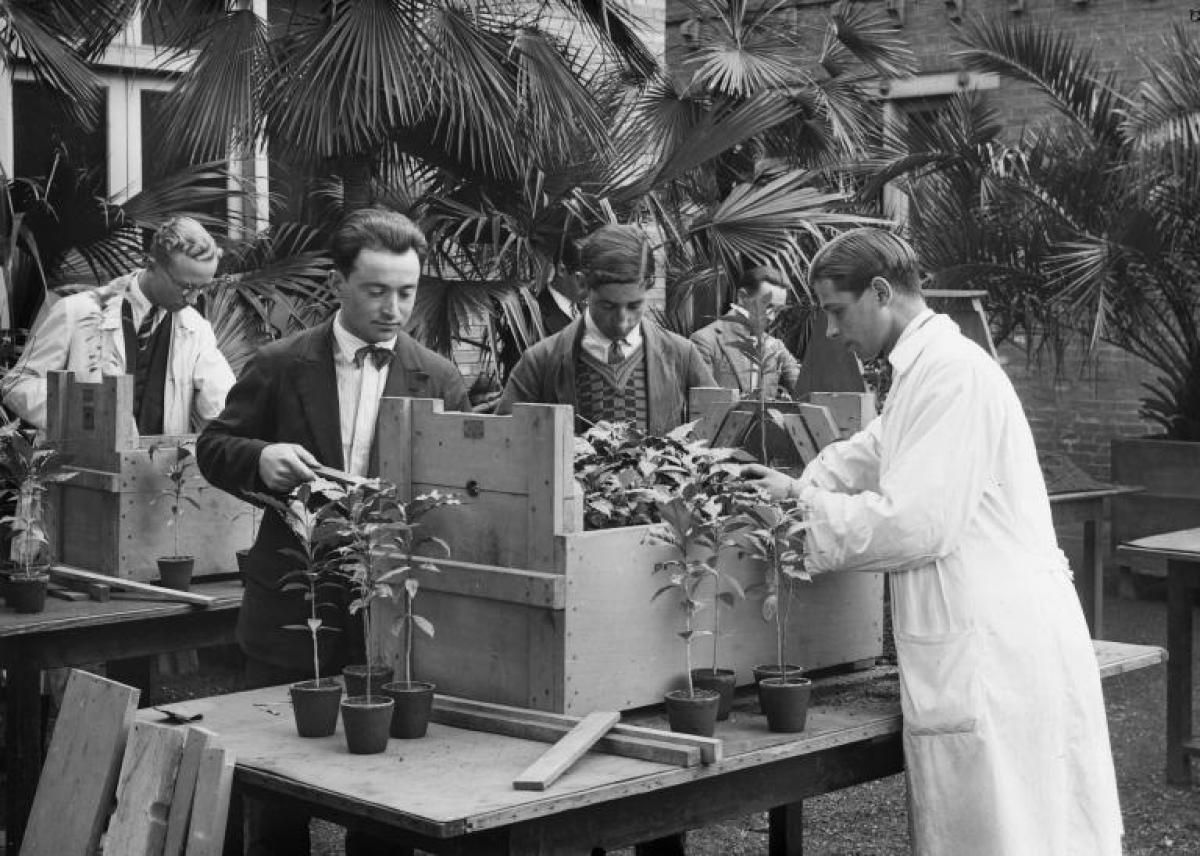Practical work by students learning about packaging processes for long-distance seed shipping, 1929. © INAC
–
–
Between 1920 and 1960, nine technical institutes for tropical agricultural research were created to strengthen knowledge and economic exploitation of tropical resources: the Rubber Research Institute (Irca), the Research Institute for Oils and Oilseeds (IRHO), the Fruit and Vegetable Research Institute (Irfa), the Cotton and Exotic Textiles Research Institute (IRCT), the French Institute for Coffee, Cocoa and Other Stimulating Plants (IFCC), the Institute of Livestock and Veterinary Medicine of Tropical Countries (IEMVT), the Tropical Forestry Technical Center (CTFT), the Institute for Tropical Agronomic Research and Food Crops (Irat) and the Center for Studies and Experimentation tropical agricultural machinery (Ceemat). Their work mainly focuses on cash crops intended for export and supply the metropolis.
Decolonization and the rise of food crops
At the end of the Second World War, the institutes were more interested in cereals and other food crops. The challenge is no longer to supply the metropolis but to help the territories to ensure their food. In 1960, the creation of the Institute for Tropical Agronomic Research and Food Crops (Irat) reflects this new ambition. Gradually, the colonial stations, plantations and trial gardens were handed over to the Newly Independent States. Technical assistance and scientific cooperation succeeded the colonial economy.
It is also the time of the green revolution. While the world’s population is exploding, the rise of industrial agriculture allows for a significant increase in agricultural production. Its pillars: genetics, inputs, mechanization and irrigation.
Towards a new “Circadian” identity
Between 1960 and 1970, several avenues of reform were explored for institutes with very different missions, statuses and cultures. The ancestor of CIRAD, the Study and Research Group for the Development of Tropical Agriculture (Gerdat), was created in 1970 to ensure better coordination.
On June 5, 1984, the Center for International Cooperation in Agricultural Research for Development (Cirad) succeeds Gerdat. The institutes then merged into this public industrial and commercial establishment (Épic), placed under the dual supervision of the Ministry of Research and the Ministry of Cooperation and Development. There followed a long period of transition and successive reforms to adapt CIRAD to the needs of a modern scientific organization, to create new relationships with international research in agriculture and to thoroughly reform the links resulting from the postcolonial period, in particular with our African partners. A period punctuated by tensions, even crises, but also innovative ideas for the scientific mission and the ambitions of the new establishment.
“Science at the center” and the 2006 reform
A player in scientific research and international cooperation, CIRAD has, since its creation, always sought a balance between its two original mandates. In the 2000s, however, CIRAD chose the research side and placed scientific excellence at the heart of its organization. The number of publications by CIRAD researchers and hosted doctoral students is exploding. In terms of the organization of research, technical assistance programs are giving way to scientific departments and research units.
The 2006 reform embodies the culmination of the “ciradien” project. The institution is officially promoted as a research organization in partnership on global public goods. The underlying observation is that the organization in sectors, until then the backbone of the institution, does not allow us to understand and support the production of global public goods: social development, well-being, environmental and health issues. This major break is reflected in a new internal organization and the creation of the three current scientific departments: “Bios” for biological systems, “Persyst” for technical systems, “ES” for social and institutional systems. The partnerships are broken down according to the major scientific questions, giving rise to the birth and development of research and teaching mechanisms in partnerships (dP).
The integration of disciplines also marks the transition from research on development to development through research. Since the companies with which CIRAD works cannot depend on the transfer of knowledge and technologies produced elsewhere, they must be developed locally, in a contextual manner, by strengthening sovereign research skills.
Today, CIRAD at the heart of international agricultural research
The establishment of the headquarters of the CGIAR consortium in Montpellier in 2011 made the city the world capital of agricultural research and confirmed CIRAD’s position as one of its pioneering and essential players. This position is reinforced by the dissemination of the culture of impact within the establishment.
Today, CIRAD is able to document the contribution of its research to building resilient agriculture. Food security, biodiversity, sustainable development objectives, agroecology… CIRAD’s expertise illustrates more than ever the pivotal role of agriculture in responding to contemporary economic, social, environmental and health issues.
–


